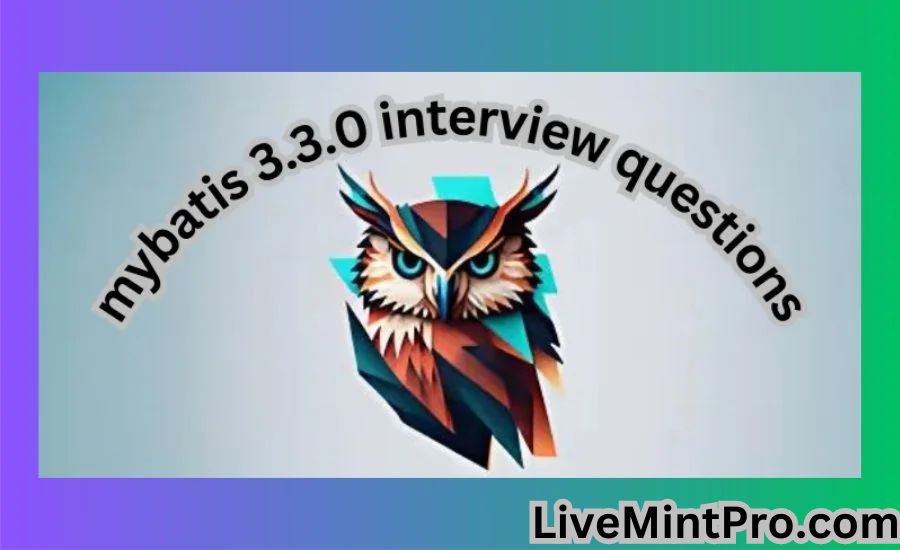Are you preparing for an interview that involves MyBatis 3.3.0? Look no further! MyBatis is a popular persistence framework that simplifies working with relational databases in Java applications. Whether you’re a seasoned developer or new to the world of MyBatis, having a solid understanding of common interview questions will help you ace your next job interview. In this article, we will explore some of the most frequent MyBatis 3.3.0 interview questions and provide insights on how to answer them confidently. For a comprehensive list of interview questions, you can check out this MyBatis 3.3.0 interview guide to enhance your preparation.
What Is MyBatis, and Why Is It Popular?
MyBatis is a Java-based framework that automates the mapping between SQL databases and objects in Java applications. Unlike traditional ORM frameworks like Hibernate, MyBatis offers more flexibility by allowing direct SQL queries while reducing boilerplate code. Its popularity comes from its ease of use, flexibility, and reduced configuration when compared to other Java persistence frameworks.
Here are a few reasons why MyBatis has gained popularity:
- Simple Configuration: It uses XML or annotations to define SQL mappings, making it easier to understand.
- Supports Complex Queries: MyBatis allows developers to write custom SQL queries, providing greater control over how the data is retrieved.
- Flexibility: It is a lightweight framework that works with any relational database, without being too invasive.
- Excellent for Legacy Systems: It can easily integrate into legacy systems and work seamlessly with existing SQL queries.
Key Features of MyBatis 3.3.0
MyBatis 3.3.0 brings several new features and improvements to the framework. Before diving into specific interview questions, it’s important to understand these key features:
- Improved Mapper Enhancements: MyBatis 3.3.0 introduced several enhancements to the mapper system, making the framework more efficient and easier to use.
- Support for Java 8 Features: MyBatis 3.3.0 added support for Java 8, allowing for lambda expressions and better stream handling in queries.
- Better Performance: The newer version focuses on performance improvements, ensuring faster query execution times.
- TypeHandler Enhancements: TypeHandlers are now more flexible in managing custom Java types and their mapping to database fields.
These updates make MyBatis 3.3.0 a solid choice for building scalable and performant applications.
Common MyBatis 3.3.0 Interview Questions
Here are some frequently asked questions during MyBatis 3.3.0 interviews, along with guidance on how to answer them:
1. What is MyBatis, and how is it different from Hibernate?
The interviewer might start by testing your knowledge of the basic differences between MyBatis and Hibernate. Your answer should highlight the following points:
- MyBatis is not a full ORM framework like Hibernate. While Hibernate generates SQL queries based on entity relationships, MyBatis allows you to write your own SQL queries.
- MyBatis focuses more on SQL and is excellent for projects that need custom query control, whereas Hibernate focuses more on automating object-relational mapping with minimal SQL.
2. How does MyBatis handle mapping between Java objects and database tables?
MyBatis allows you to define mappings using XML configuration files or annotations. These mappings link database columns to Java class properties. The framework handles the data conversion automatically based on these mappings. This helps reduce the boilerplate code you would otherwise have to write to handle the conversion manually.
3. Can you explain the role of the SqlSession in MyBatis?
The SqlSession interface in MyBatis is responsible for executing SQL queries, committing or rolling back transactions, and closing resources. Here are the key points to cover in your answer:
- SqlSession is the primary interface used by MyBatis to interact with the database.
- It manages the session lifecycle, handles connections, and performs CRUD (Create, Read, Update, Delete) operations.
- You should always close the SqlSession after use to avoid resource leaks.
4. What are MyBatis Mappers, and how do you define them?
Mappers in MyBatis are interfaces that contain methods corresponding to SQL statements. Each method in the mapper interface is associated with a SQL query that it executes. Mappers can be defined using either:
- XML files: where you define SQL queries with <select>, <insert>, <update>, and <delete> tags.
- Annotations: where you can annotate methods in the mapper interface with the corresponding SQL statements.
5. What are TypeHandlers in MyBatis, and how do they work?
A TypeHandler in MyBatis is responsible for converting between Java types and database types. For example, it converts a String to a VARCHAR in SQL, or a Date to a TIMESTAMP. You can also create custom TypeHandlers if you need to handle complex types or transformations between Java objects and database fields.
6. How do you manage transactions in MyBatis?
MyBatis allows you to handle transactions either programmatically or declaratively. When managing transactions programmatically, you have to call commit() and rollback() methods manually in your code. For declarative transactions, MyBatis can integrate with Spring’s transaction management, which automatically handles commits and rollbacks.
Why MyBatis 3.3.0 Is Ideal for Java Developers
MyBatis 3.3.0 is a highly flexible framework that gives Java developers precise control over their SQL queries. Its combination of simplicity and power makes it a great choice for applications that require complex query handling or integration with existing SQL databases.
For developers preparing for a MyBatis-related job interview, understanding these key concepts and familiarizing yourself with the most common questions can give you the edge you need to succeed. If you’re looking for additional MyBatis resources or want to explore a deeper list of questions, you can check out the full set of MyBatis interview questions on BlogRouters.
Conclusion
Mastering MyBatis 3.3.0 can significantly improve your chances of landing a job that requires strong database skills. The key to acing MyBatis interviews lies in understanding its unique features, including how it differs from other frameworks like Hibernate, how to work with Mappers, TypeHandlers, and how to manage transactions. Don’t forget to practice your answers to common interview questions and review the important features introduced in MyBatis 3.3.0. To learn more about related frameworks and Java technologies, feel free to explore BlogRouters for additional resources and guides.
Get the Latest Updates On LiveMintPro





